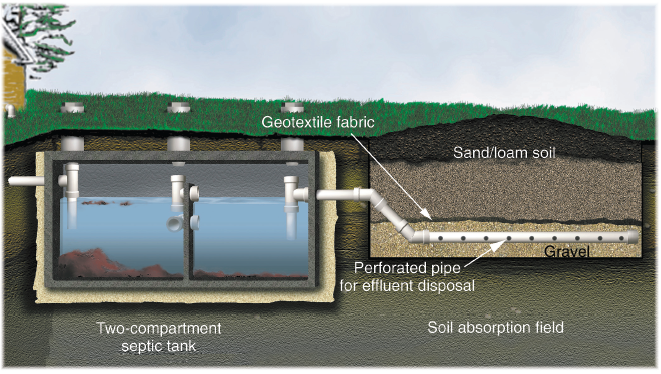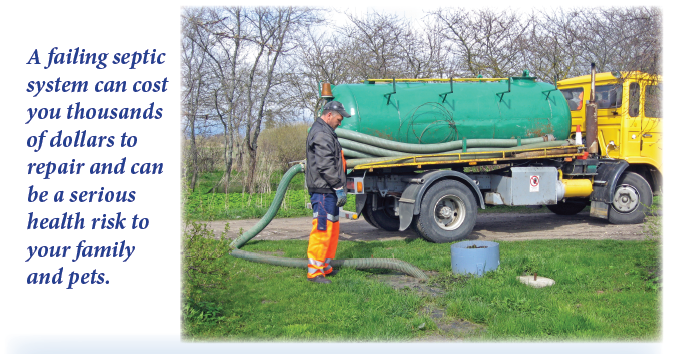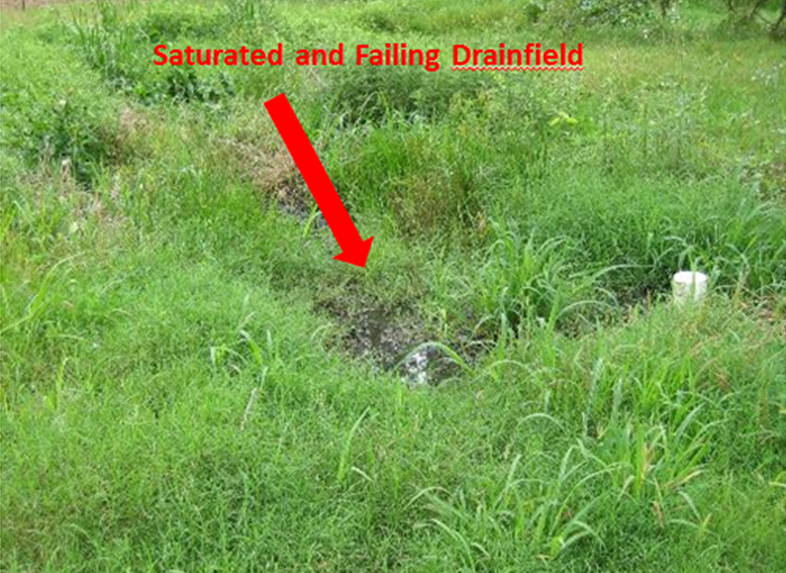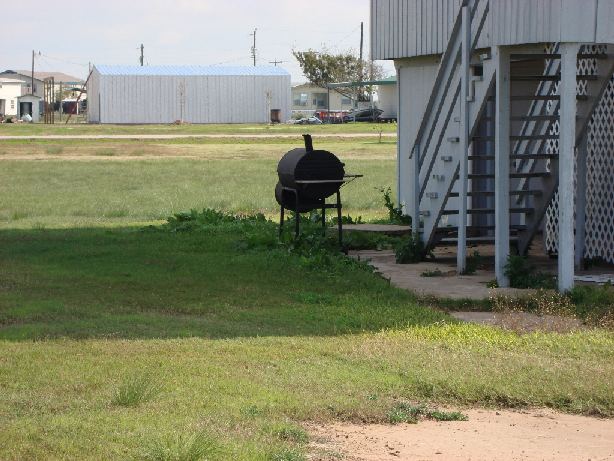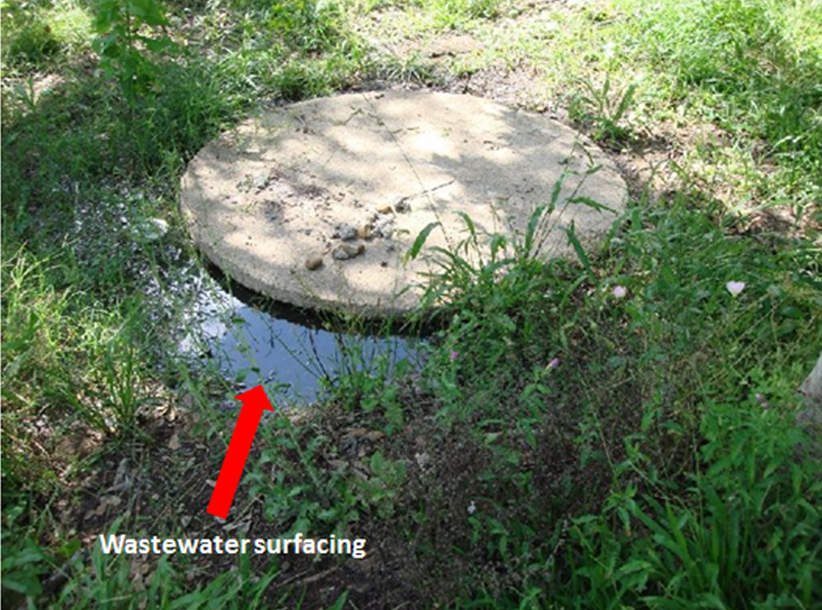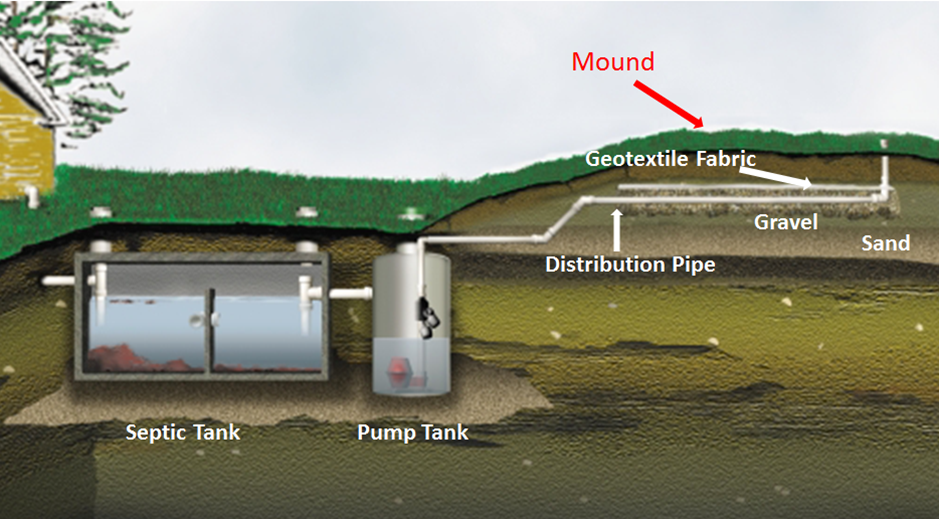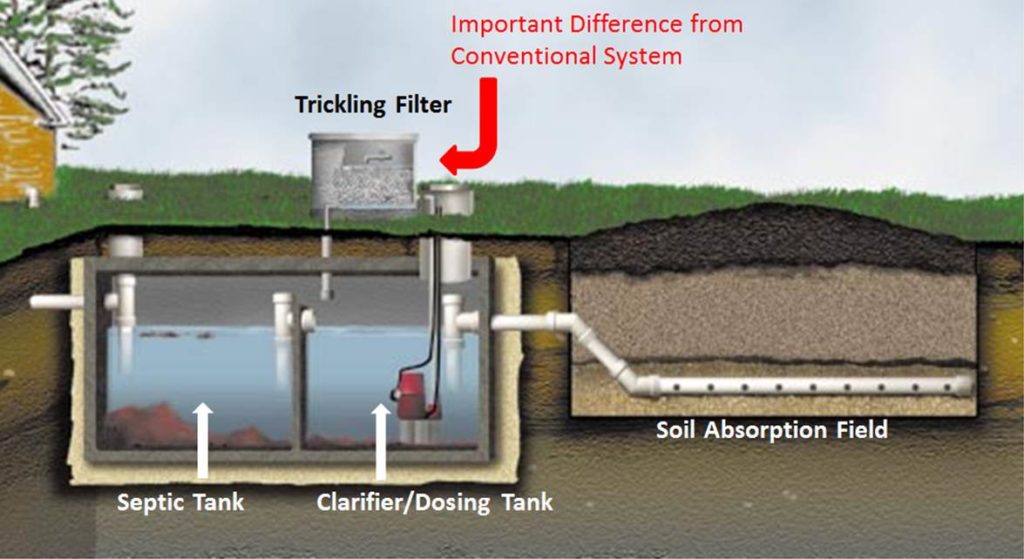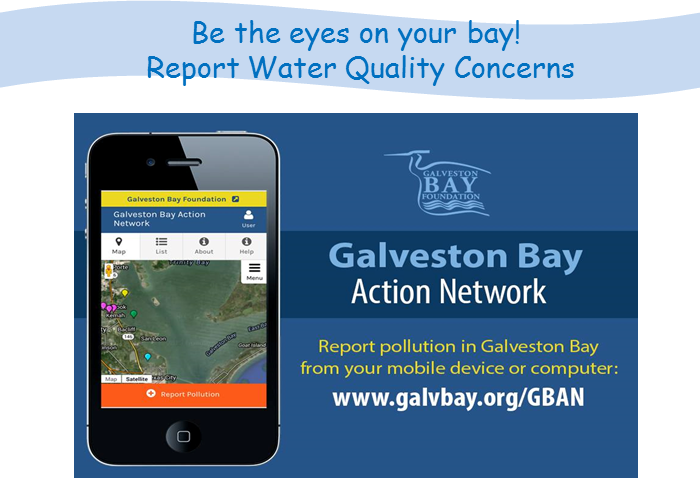When you flush the toilet, use the sink or do laundry, water flows down the drain and into your septic system.
In the Tank, Wastewater Settles into 3 Layers:
- Top Layer-Lighter oils and fats float to the top, creating scum.
- Middle Layer- Clarified water collects in the middle and then flows into a distribution box.
- Bottom Layer- Heavier water sinks to the bottom, forming sludge.
Effluent Distribution
Clarified water from the distribution box flows through small holes in distribution lines, allowing the wastewater to drain into gravel trenches for temporary storage.
In the Soil Absorption Field
The effluent slowly seeps into the subsurface soil, where it is further treated and purified by the soil’s microorganisms.
Leach or drain field systems rely on the soil to treat and purify the wastewater before it enters a water body, such as a bayou or a creek. However, we live in an area with high rainfall and a shallow water table, so the soils don’t have adequate time (or soil depth) to filter your waste water before it flows into drainage ditches and waterways.
In clay soils, water filters more slowly than in sandy or silty soil, causing water to back up in your system. When the effluent can’t filter through the soil, it flows along the top, untreated, into our bayous, creeks and bays.
1. Trash these items, don’t drop them down the toilet or drain:
Kitchen scraps-use a sink strainer, not a garbage disposal
Fats, oils and grease- storing oils in a glass jar and disposing in trash when full is one possible solution
Baby wipes, tissues, paper towels, excessive toilet paper
Floss, hair, feminine products, condoms, kitty litter, and pet waste
2. Save your money:
Don’t use septic additives. Really. At best they do nothing; at worst they can kill the good bacteria in your system.
Don’t use more than the label’s recommended amount of bleach, detergent, or drain de-clogger. These too can kill your good bacteria.
If you have a large family that uses bath oils, you may want to reconsider or limit use of these oils- you’ll be paying to remove them when you get your system pumped.
Use water saving technologies (shower heads, water saving toilets) to save on water usage and to keep your septic tank from overflowing.
3. Return these items to a designated return center:
Oil based paint, harsh chemicals or cleaners-take these items to a hazardous waste drop-off day in your city or county.
Expired or unwanted medications-take to your pharmacist or a medicine take-back day in your city or county.
To find the nearest recycling center that accepts some of the items mentioned above, visit the HGAC Recycling Centers map.
DO…
have your tank pumped out and system inspected every 3-5 years depending on the size of the tank and of your family. Contact the Galveston County Health District for a list of septic contractors licensed in your area.
Do keep a record of pumping, inspections and repairs. It will come in handy when you want to sell or rent your house.
Do commit to water conservation. Repair drips and leaks. Use water-saving showers, toilets, and faucets.
Do use your garbage disposal sparingly. It puts a heavy burden on your septic system.
Do divert flood drain and surface water run-off away from your septic system and leach field.
DON’T…
drive or park anything heavier than a riding lawn mower over any part of your system.
Don’t plant shrubs or trees over your system. Roots may clog and damage your lines or leach field.
Don’t use your toilet as a trash can or for food disposal.
Don’t dispose of cooking oil, fat and grease in your septic system.
Don’t use commercial septic system additives.
Don’t make or allow any repairs to your system without the proper permits from the Health District.
Don’t pour hazardous chemicals, paints, or unused prescriptions down the drain.
How large is your household? Use this chart to estimate how often you should be pumping your septic system.
Things to keep in mind:
> Just because its flushing doesn’t mean your system is okay.
> A system with one malfunctioning part is a malfunctioning system.
> Lawns or fields that are saturated with rainwater are unable to accept wastewater from your septic system.
> Foul odors after heavy rainfalls is a good indication that the system is not working as it should.
Patches of muddy lawn-especially when its been weeks since the last rain may indicate that your system is overloaded hydraulically.
The excessive water loving vegetation surrounding the tank is an indication that the tank is not water tight.
Wastewater surfacing around the tank is an indicator that the drainfield has failed on this system.
Saturated conditions surrounding a spray indicates it may be broken.
> Protect the health of the people and pets living on and near your property.
> Help safeguard your property’s value.
> Help preserve the quality of groundwater and prevent your sewage from degrading nearby waterways.
> Routine maintenance and basic changes in personal water use can save you BIG bucks.
> Reduces foul odors and muddy seepage to your lawn.
If your system is old and failing, this may be an opportunity for you to upgrade to an easier, cleaner, and more modern system. Galveston County requires that new systems get a routine permit and be installed by a licensed professional. The following are some alternatives to discuss with your system designer:
Aerobic Systems:
Treats wastewater using the same process, on a smaller scale, as our municipal wastewater treatment facilities. They remove 85 to 98 percent of the organic matter and solids, producing effluent as clean as from a municipal facility, and cleaner than effluent from conventional septic tanks.
An elevated absorption bed that utilizes suitable sands to partially treat wastewater before it reaches native soil. Mound systems are used to augment native soils for complete treatment and disposal.
These are common in Galveston County because of high water tables and clay soils.
A drip system that distributes the effluent uniformly across the lawn for reuse by the plants in the landscape to prevent over-saturating the soil.
Consists of beds of gravel or sand, which drains from underneath so pretreated wastewater can be collected and distributed through the final treatment and dispersal system.
Pumps partially-treated effluent into the soil several times throughout the day. This system works well in clay soil because it spaces out the time between inundation.
To access fact sheets on additional alternatives, fact sheets in Spanish and other helpful guides, visit the AgriLife Extension page on On-site Sewage Facilities (OSSF).
- Your septic system: What to do after a flood?
- Manuals and technical assistance
- Preventing Septic System Failures
- Sewage treatment rules, operation, maintenance tips, and and requirements
- Licensing or Registration Information Search
- Galveston County Health District


